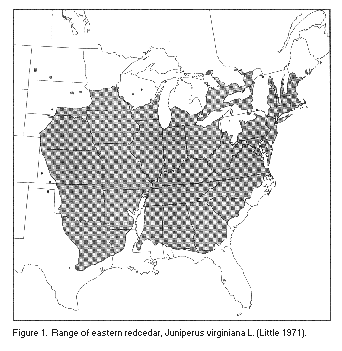An Annotated Bibliography of Eastern Redcedar
Introduction
Return to Table of Contents
This annotated bibliography of published literature on eastern redcedar (Juniperus virginiana L.) contains 719 references to both technical and popular articles available as of September 1994. We compiled this bibliography to provide a working tool for people interested in eastern redcedar. It is intended to serve as an international reference for literature and research about eastern redcedar. Most of the literature cited was located through computerized, global literature searches. In addition, we searched citations from eastern redcedar related publications and libraries for eastern redcedar references. Citations available after September 1994, unpublished theses and typewritten reports, are not included. The annotations provide a general idea of the information and results and are not intended to be complete abstracts. In broad-based articles, we excerpted only the information relevant to eastern redcedar. We tried to keep the organization of this bibliography simple; it is arranged by subject area and alphabetically by author with a number assigned to each entry. The number of the publication is listed by each author in the author index.
The Juniperus genus, in the Cupressaceae family of conifers, consists of about 70 species of trees and shrubs widely scattered throughout the Northern Hemisphere. Eastern redcedar (Juniperus virginiana L.) is the most widely distributed conifer of tree size in the Eastern United States, and it is indigenous in every State east of the 100th Meridian and in southern Ontario (fig. 1).

Eastern redcedar is a small to medium tree that can grow up to 60 feet in height and can attain bole diameters of more than 24 inches at breast height. The crown is dense and narrowly pyramidal or columnar, with the bole tapering to a potentially deep root system. The American Forestry Association's 1994 National Register of Big Trees lists the champion eastern redcedar as having a bole circumference of 211 inches, a height of 55 feet, and a crown spread of 68 feet. It is located at the Lone Hill Church Cemetery in Coffee County, Georgia.
Eastern redcedar grows under a wide range of climatic and soil conditions. Annual rainfall ranges from approximately 16 inches to almost 60 inches, and length of growing season ranges from 120 to 250 days. Soil types range from acidic sands to those derived from limestone. The best growth is made on deep alluvial soils. Eastern redcedar is most common on dry soils, in pure stands or open mixtures with pines or hardwoods. It is a slow-growing and somewhat shade-intolerant tree.
Eastern redcedar is commonly used for posts, novelty items, chests, and as shelterbelts/ windbreaks. It is an important species for wildlife food and cover. Considerable variation in color and compactness makes eastern redcedar and its cultivars among the best of native ornamental evergreens.
This bibliography is a follow-up to E.R. Ferguson's "Eastern redcedar: an annotated bibliography," published in 1970 by the Southern Forest Experiment Station. We felt that the significant number of publications added to the literature since 1970 warranted this update. For more information about Ferguson's earlier publication, please see:
Ferguson, E.R. 1970. Eastern redcedar: an annotated bibliography. Res. Pap. SO-64. New Orleans, LA: U.S. Department of Agriculture, Forest Service, Southern Forest Experiment Station. 21 p.
The use of trade names does not consitute endorsement by the U.S. Department of Agriculture
Return to Table of Contents